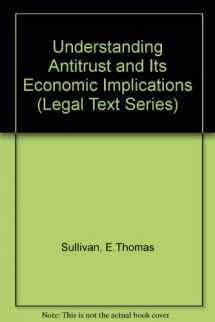
Understanding Antitrust and Its Economic Implications (Legal Text)
ISBN-13:
9780256164459
ISBN-10:
0256164452
Edition:
2
Author:
E. Thomas Sullivan, Jeffrey L. Harrison
Publication date:
1994
Publisher:
Lexis Nexis Matthew Bender
Format:
Paperback
46 pages
FREE US shipping
Book details
ISBN-13:
9780256164459
ISBN-10:
0256164452
Edition:
2
Author:
E. Thomas Sullivan, Jeffrey L. Harrison
Publication date:
1994
Publisher:
Lexis Nexis Matthew Bender
Format:
Paperback
46 pages
Summary
Understanding Antitrust and Its Economic Implications (Legal Text) (ISBN-13: 9780256164459 and ISBN-10: 0256164452), written by authors
E. Thomas Sullivan, Jeffrey L. Harrison, was published by Lexis Nexis Matthew Bender in 1994.
With an overall rating of 3.9 stars, it's a notable title among other
books. You can easily purchase or rent Understanding Antitrust and Its Economic Implications (Legal Text) (Paperback) from BooksRun,
along with many other new and used
books
and textbooks.
And, if you're looking to sell your copy, our current buyback offer is $0.45.
Description
This Understanding treatise is designed to supplement any antitrust casebook. When the first edition was published over twenty years ago, the Supreme Court was in the midst of reshaping antitrust law to reflect its philosophy that it should adhere to the teachings of economics. During the six years since the Fourth Edition was published, this process has continued as the Court sought to achieve greater consistency. For example: The Court removed resale price maintenance (RPM) from the list of per se unlawful activities. The Court has also made it clear that it would treat secondary line price discrimination - perhaps the last remaining element of the populous antitrust philosophy of the 1960s - in a manner consistent with its emphasis on efficiency. The Court made one of its first forays into the theory of monopsony and addressed the question of how antitrust law applies to market power on the buying side of the market. The process of rationalizing antitrust law is far from complete. For example, the Court's newly announced position on RPM raises a number of issues. Specifically, many past decisions by the Supreme Court and lower courts reflect either approval or disapproval of the per se status of RPM. Now that the rule has been changed, the relevance of that law is in question. In addition, a truly consistent antitrust policy requires close attention to various exemptions. Exemptions based on non economic considerations are hard to reconcile with the path the Court has chosen. Finally, in a global economy, matters of market power and the competitive impact of various agreements must be viewed from an international perspective.


We would LOVE it if you could help us and other readers by reviewing the book
Book review

Congratulations! We have received your book review.
{user}
{createdAt}
by {truncated_author}


